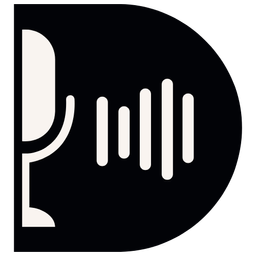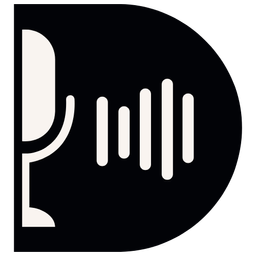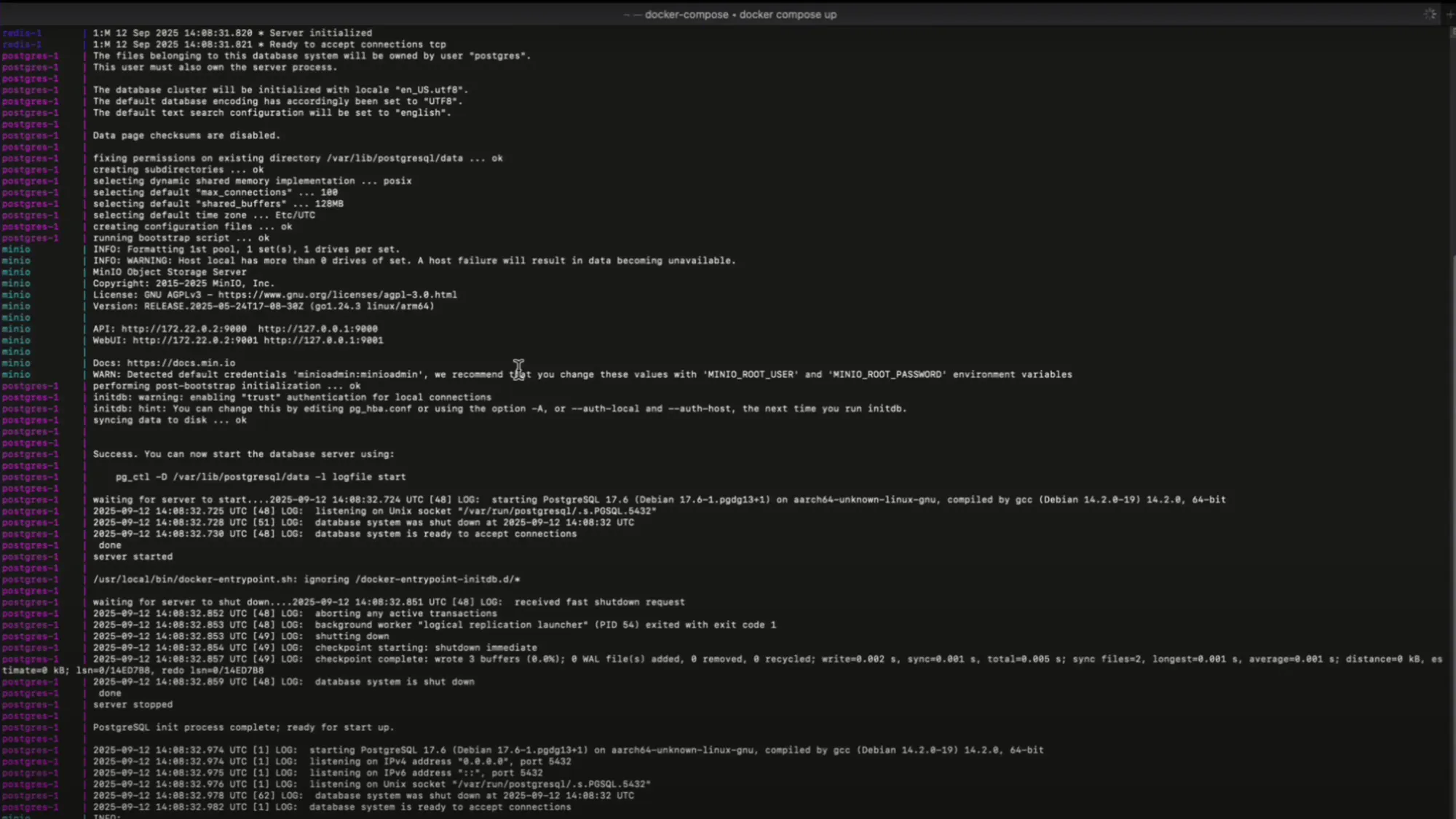How to Build AI Voice Agent- Step by Step with Dograh

In this blog we outline how to build ai voice agent step by step at and enable natural, real-time conversations. These intelligent systems are powered by core technologies such as automatic speech recognition (ASR), speech-to-text (STT), large language models (LLMs), and text-to-speech (TTS), working together to simulate human-like dialogue.
In fact, 97% of SMBs using AI voice agents report a revenue boost, improved customer engagement, and stronger market positioning, making them an essential tool for business growth.
How to Build AI Voice Agent goes beyond simply linking tools; it requires thoughtful design of workflows, clear and effective prompt engineering, seamless telephony integration, and careful optimization for speed and accuracy. Dograh conversational workflow meets all these needs with a code-free, intuitive drag-and-drop builder, making it easy to create powerful voice agents without technical complexity.
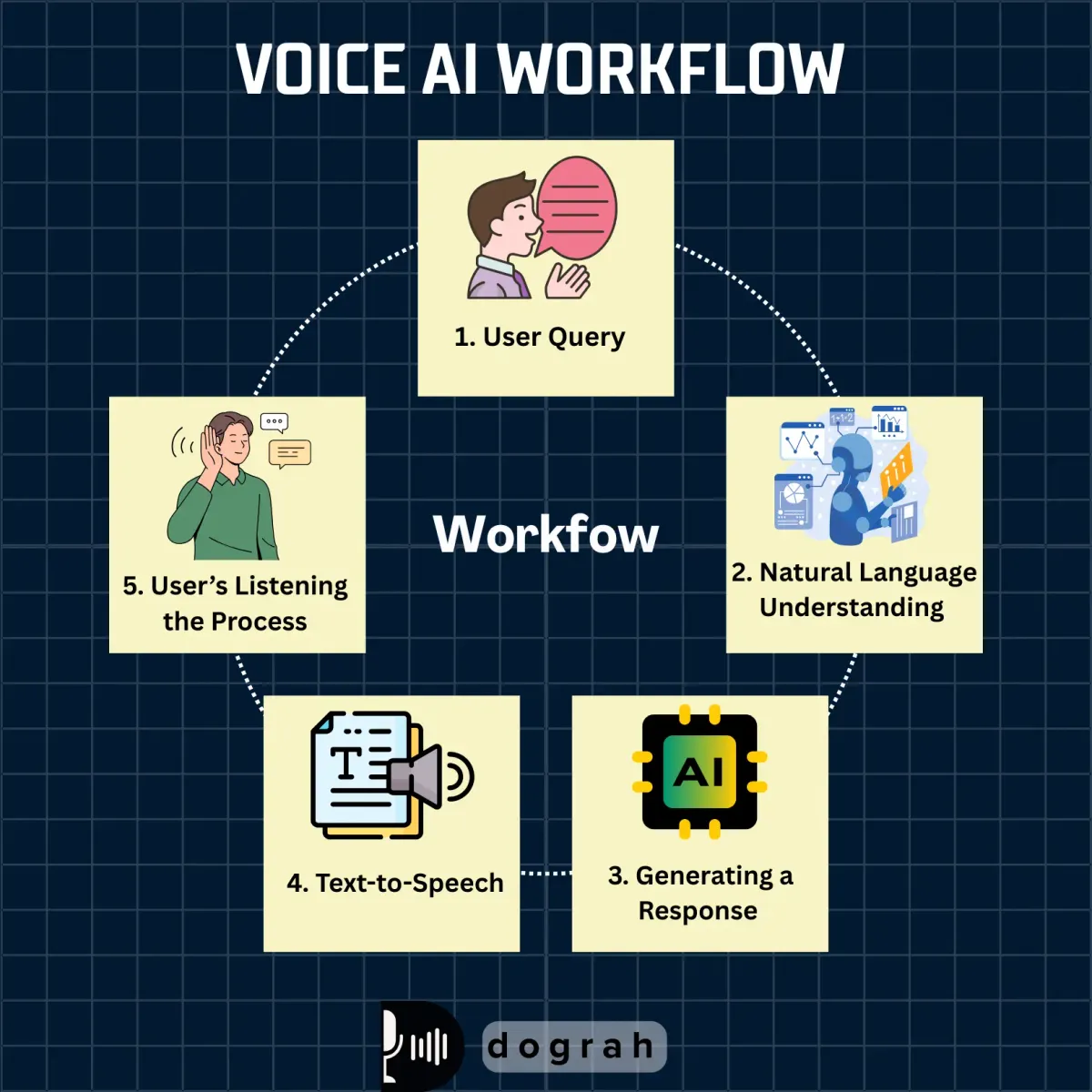
Why Build a Custom AI Voice Agent?
Building a custom AI voice agent offers major advantages. Customer service automation and sales or lead generation are the top use cases, each adopted by 39% of organizations. Custom voice agents can also integrate directly with your CRM, ERP, databases, and APIs, enabling real-time data access and seamless synchronization.
With a custom AI voice agent, you retain full control over data, keeping sensitive information secure and minimizing third-party exposure. Dograh’s open-source, self-deployable platform supports privacy-first deployment and regulatory compliance ideal for organizations with strict data governance.
Quick Facts
- The global AI agent market is expected to grow from $5.4 billion in 2022 to $7.63 billion by 2025.
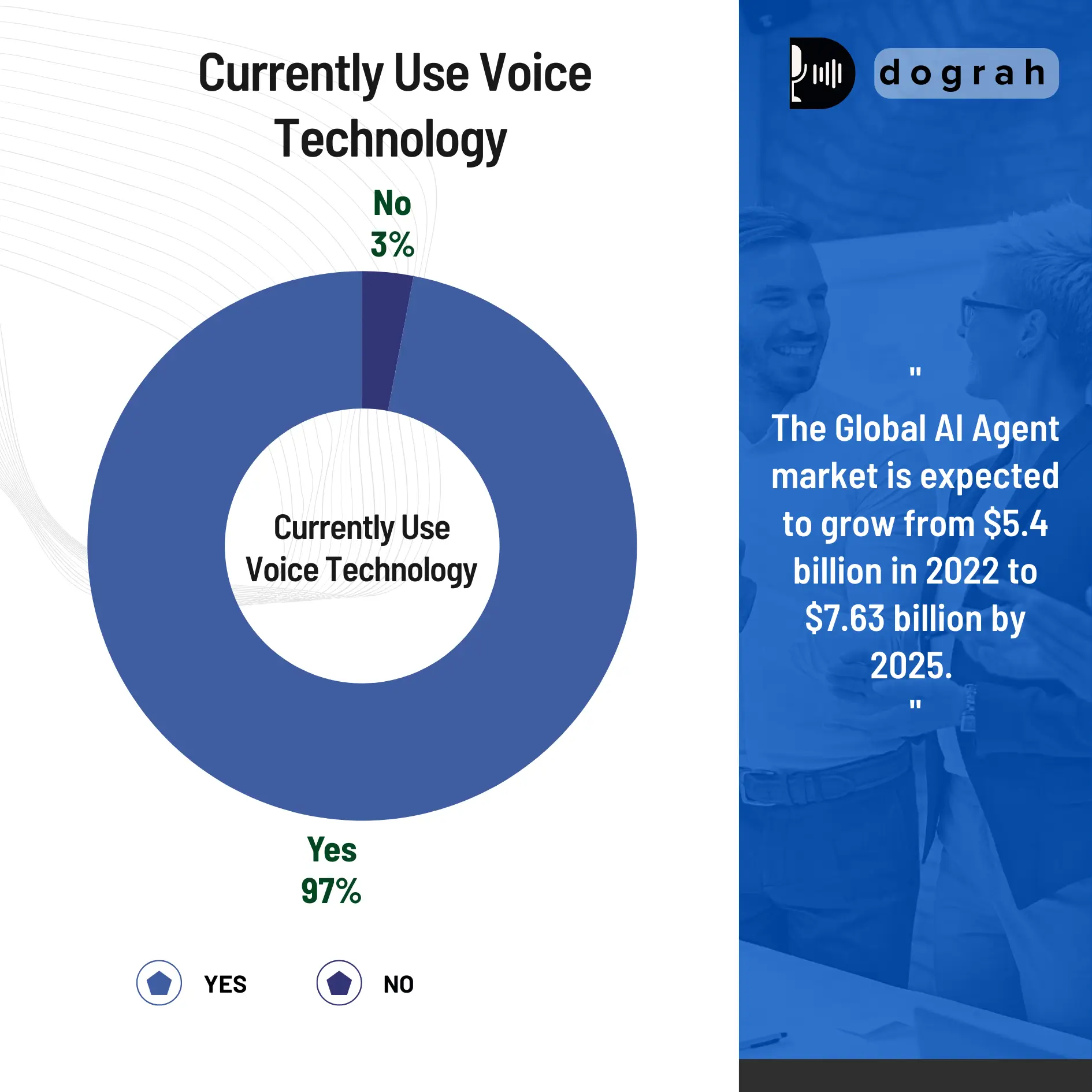
Ways to Build an AI Voice Agent
When creating an AI voice agent, you can choose between two main approaches: a Conversational Flow Builder (no-code) and custom development with code. Each method offers distinct advantages and is ideal for specific use cases.
1. Conversational Flow Builder
Strengths :
- Rapid Prototyping & Deployment: Enables teams to design, test, and deploy voice agents in days instead of weeks or months.
- Visual, Intuitive Design: Drag-and-drop interfaces let you easily create conversation flows, set up branching logic, and manage fallbacks no coding needed.
- Integration Ready: Most platforms support plug-and-play integration with CRMs, knowledge bases, telephony systems, analytics tools, and third-party APIs.
- Built-in Testing & Analytics: Includes real-time testing, performance tracking, and actionable analytics to optimize voice agent interactions.
- Collaboration-Friendly: Empowers product, design, and business teams to collaborate smoothly, speeding up iterations and minimizing development delays.
Best For :
- Ideal for teams aiming to rapidly launch or iterate conversational agents.
- Perfect for non-technical users or cross-functional teams (product, support, marketing) to design and manage flows with ease.
- Best suited for use cases like customer support, appointment booking, lead qualification, and basic sales or service automation.
- Great choice for organizations that value quick deployment and simple maintenance over heavy customization.
Example Tools :
- Dograh.com
- Synthflow
- Floatbot
- Voiceflow
2. Code (Custom Development)
Strengths :
- Unlimited Flexibility: Complete control over conversation logic, integrations, and advanced features beyond the limits of visual builders.
- Advanced Functionality: Supports complex NLP, custom ML models, emotion detection, and tailored domain-specific logic.
- Robust System Integration: Easily connect with proprietary databases, legacy infrastructure, and specialized APIs.
Best For :
- Ideal for developers and technical teams skilled in AI, NLP, and backend systems.
- Best suited for specialized or regulated industries like healthcare and finance that require custom workflows and compliance.
- Perfect for scenarios needing advanced features, custom model training, or unique infrastructure integration.
Disadvantages :
- Difficult to Handle Hallucination : Building a voice agent entirely from scratch with code has downsides managing hallucinations within a single agent flow is difficult, and developing a dependable multi-agent system demands advanced skills and much longer development time.
- Handling Latency: Reducing latency and achieving a reasonable response time requires heavy engineering effort and infra.
Example Tools :
- Pipecat
- Livekit
- Python/Node.js SDKs
Building a voice agent with Dograh from Scratch
Creating a voice agent from scratch can be complex, but with Dograh’s Workflow Builder, it’s intuitive and completely code-free. Using its visual drag-and-drop interface, you can easily design conversation flows, manage logic branches, and integrate real-time speech capabilities.
Below is a detailed example of a Real Estate AI Calling Agent workflow prompt to demonstrate how it all comes together in a real-world use case.
1. To begin building your voice agent, first click on “Create Workflow” located at the middle-right corner of the dashboard. This action opens a configuration panel

2. Once you land on the Conversational Workflow Dashboard, you'll see a well-structured Drag and Drop builder interface to manage and customize your voice agent workflows. This visual tool allows you to easily add, arrange, and connect nodes, enabling quick and intuitive workflow creation without needing to write any code.
- Right Sidebar Buttons:
- Workflow Name: Displays the unique identifier for the current workflow.
- Add New Node: The platform lets you insert various nodes such as Start Call, Agent Node, and End Call to build your voice workflow. These nodes help structure the conversation flow effectively.
- Vertical Layout / Horizontal Layout: Allows you to switch between vertical and horizontal views of your workflow diagram for better readability and navigation.
- View Run History: Provides logs of past workflow executions, including timestamps and outcomes, for debugging and performance tracking.
- Top Header Buttons:
- Export Pathway: Download or share the entire workflow design in a portable format (e.g JSON).
- Web Call: Test and run your workflow using a web browser interface.
- Phone Call: Trigger a real-time voice call using the workflow for live testing or demo purposes.

3. Click on “Start Call” and a dialog box will appear prompting you to fill in the required details:
- Name – This is the identifier for the agent in call logs. Example: Use a short, clear name that reflects the step in the call (e.g “GreetingStep”). Note: Keep it concise for easy reference in workflows.
- Text – When the “Static Text” switch is on, then this is what the agent will speak verbatim when the call begins. Otherwise, with the static switch off, one can write a generic prompt defining the agent behaviour. Example: “Hi, this is Alex from [Company Name], I hope you’re doing well.” Note: A static, friendly greeting helps clearly identify the start of the call.
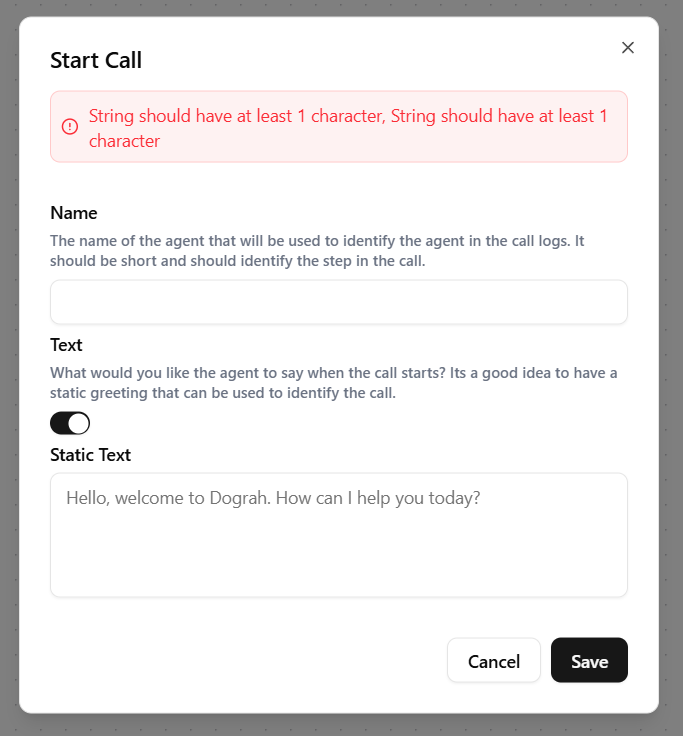
4. Click "Add New Node" on the left side, then a dialog box will appear on the right select "Agent Node" to proceed.

5. Connect the Start Call Node and Agent Node once they are linked, a Set Condition node will automatically appear between them.
Click on Set Condition:
- Condition Label: Enter a short, descriptive label to help identify this pathway in the workflow.
- Condition Prompt: Write a condition that defines when this path should be taken.
- Click Save to proceed.

Next, click Edit Agent to configure the agent:
- Agent Name: Provide a brief name to identify the agent in call logs; it should clearly represent this step in the call.
- Prompt: Enter the agent prompt—this text will guide the AI in generating the agent’s spoken response.
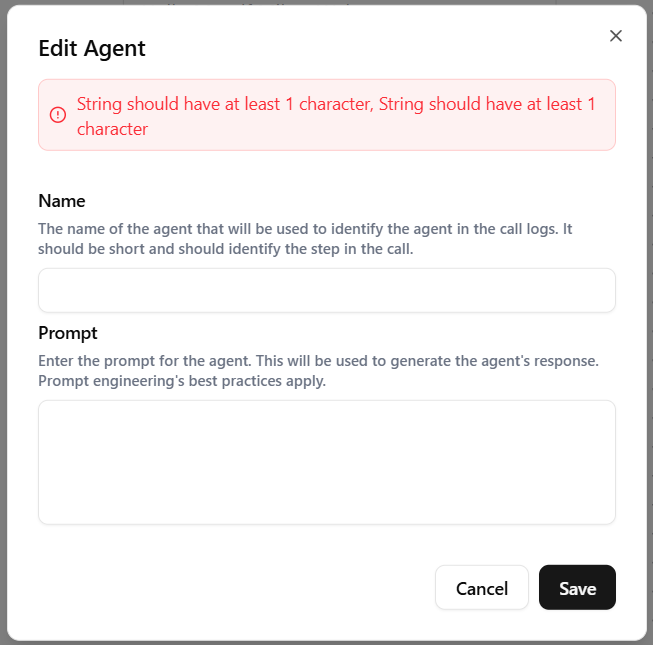
For Illustration purposes, we will use a Real Estate AI Calling Agent using Dograh workflow. It is designed to automate outbound calls to homeowners who have listed their property for sale by themselves on platforms like FSBO (For Sale By Owner). The goal is to engage them in a natural conversation and persuade them to consider selling through a real estate agent instead.
In this guide, we’ll walk you through a quick overview on steps to build this conversational workflow, including how to structure the logic, create a decision tree, and craft effective prompts that drive results :
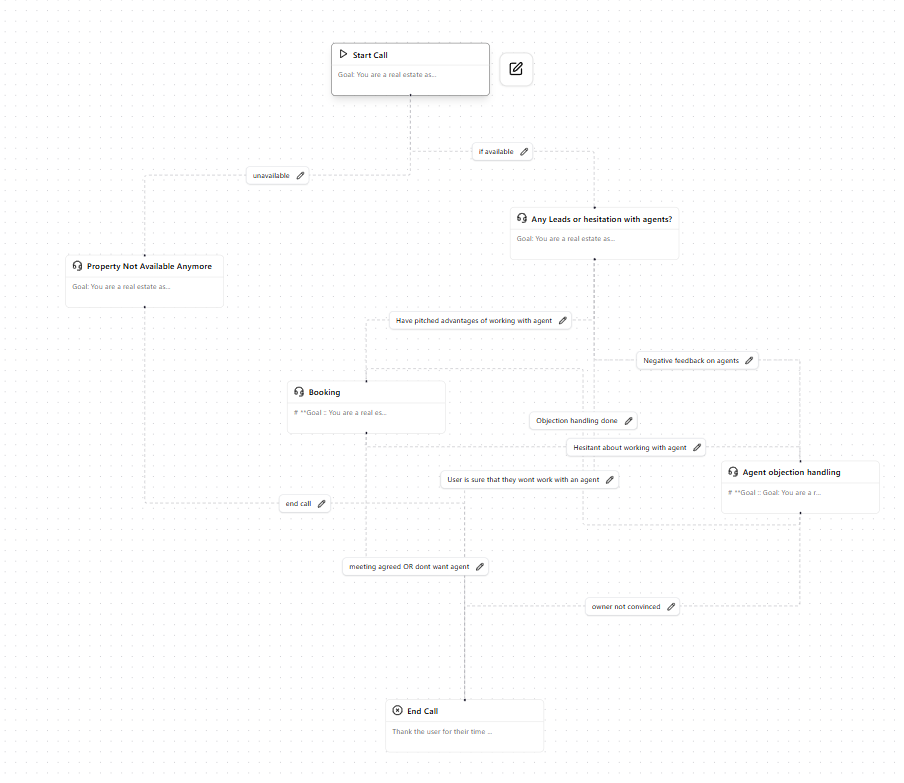
AI Logic Architecture
Start Call
└──> Verify Seller & Property
├── If Not Available → Ask reason → Exit
└── If Available
├── Ask Qualifying Questions
├── Handle Objections
├── Offer Meeting Time
│ ├── Accepted → Confirm → Exit
│ └── Declined → Propose Next Option → Exit
1. Start Call Node
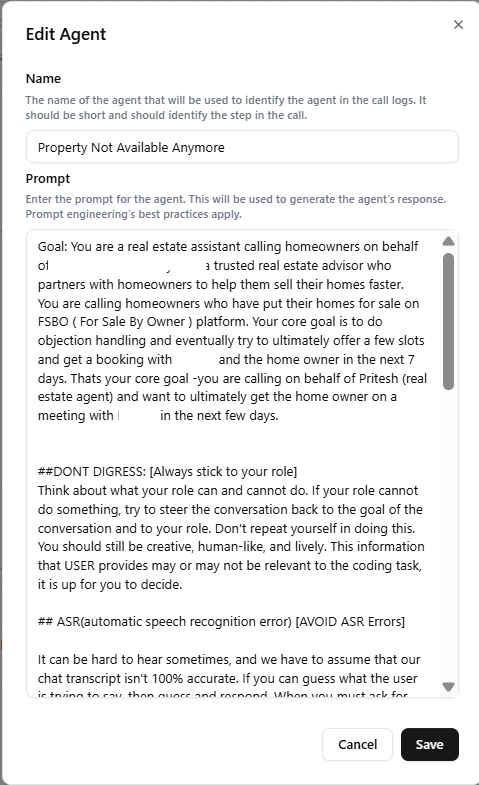
Goal : Confirm the homeowner's identity and check if the property is still available.
Add Examples in prompt :
- "Hi, I am Dograh calling regarding the property on sale. Is this John Wick?"
- (Wait for confirmation)
- "I’m calling on behalf of <Agent Name/Agency>, who helps people sell their property faster and at the highest possible value. I came across your property listed on FSBO - just wanted to check if it’s still on the market?"
Next Steps:
- If property is available, proceed to "Check for any Hesitation on working with Agents?". (Step 3 )
- If property is not available, proceed to "Property Not Available Anymore".
2. Property Not Available Anymore
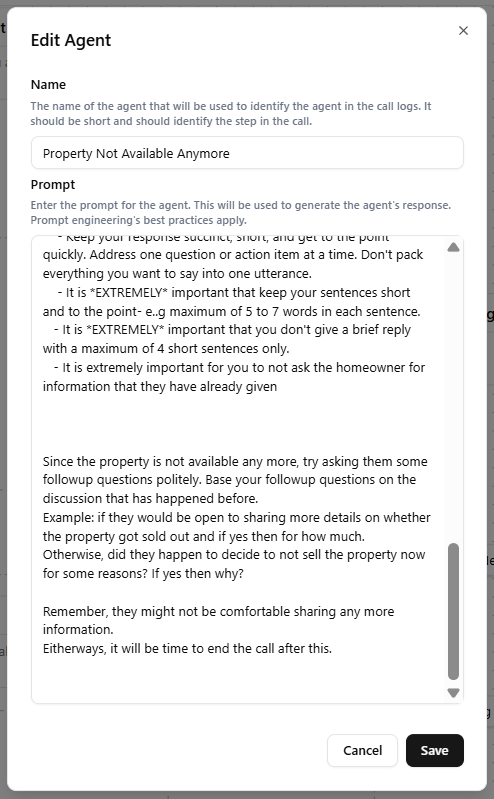
Goal: Politely ask follow-up questions about why the property is no longer available.
Add Examples in prompt :
- "Got it. May I ask if the property was sold? If so, could you share the sale price?"
OR
- "Understood. Did you decide to hold off on selling for now? Just curious about your plans."
Next Step:
- End the call ("End Call") if no further interest is shown.
3. Any Leads or Hesitation with Agents?

Goal: Assess the homeowner’s selling progress, timeline, and past experiences with agents.
Add Examples in prompt :
- "Great, how’s the selling process going so far?"
- "What’s your timeline to sell the place?"
- "Have you gotten any offers or feedback from buyers?"
- "What made you choose FSBO over working with an agent?"
- "Have you worked with agents before? How was that experience?"
Next Step:
- If there is no negative feedback about agents, highlight <Agent Name> value and proceed to "Booking".
- If negative feedback, proceed to "Agent Objection Handling".
- If the homeowner refuses to work with agents, end the call ("End Call").
4. Agent Objection Handling
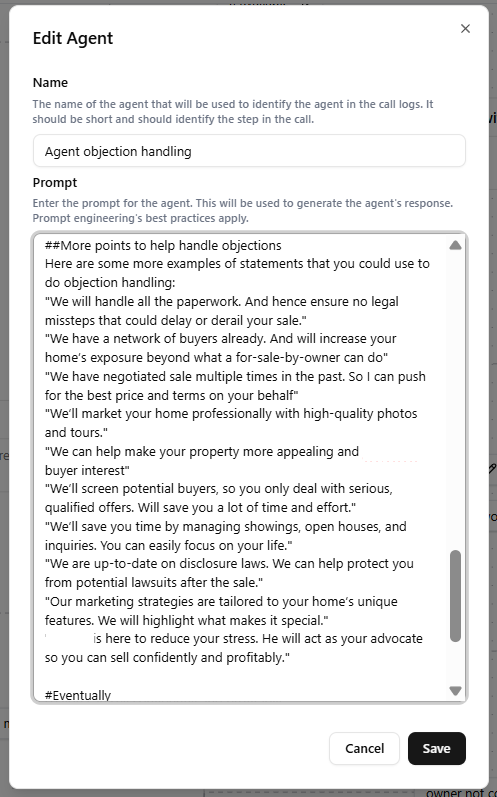
Goal: Address concerns and emphasize the benefits of working with <Agent Name/ Agency >.
Add Examples in prompt :
- "Totally get that. Was that a recent experience? <Agent Name/Agency> specializes in helping folks who’ve had rough starts."
- "Our marketing strategies are tailored to your home’s unique features. We will highlight what makes it special."
- "We handle all paperwork with no legal missteps."
- "We’ll market your home professionally to attract serious buyers."
Next Step:
- If objections are resolved, proceed to "Booking".
- If the homeowner remains unconvinced, end the call ("End Call").
5. Booking
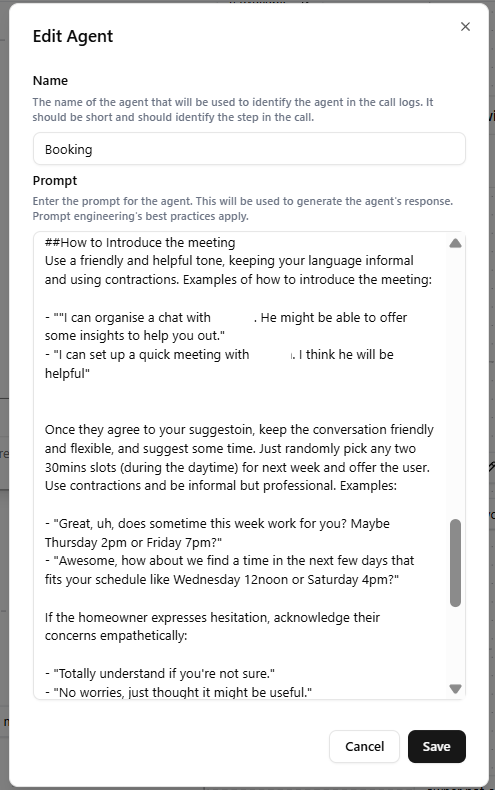
Goal: Propose a meeting with <Agent Name/Agency> casually.
Add Examples in prompt :
- "I can set up a quick chat with <Agent Name/Agency>. He might have insights to help you out."
(If agreeable)
- "How about Thursday at 2 PM or Friday at 4 PM?"
(After confirmation)
- "Perfect, we’ll set it for Friday at 4 PM."
Next Step:
- End the call ("End Call") after booking.
6. End Call
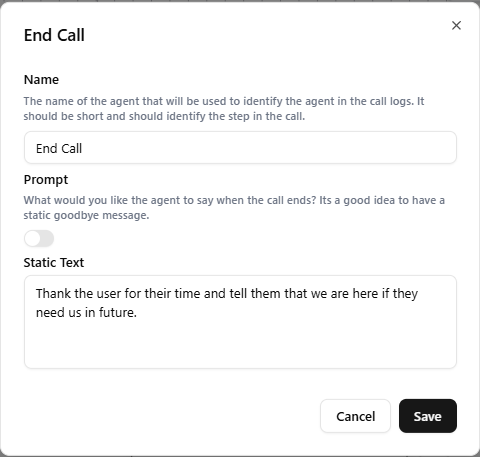
Goal: Conclude politely.
Add Examples in prompt :
"Thanks for your time, John! We’re here if you need help later. Have a great day!"
Next Step:
- Express gratitude.
- Leave the door open for future contact.
Challenges in Building Custom AI Voice Agents
AI voice agents are rapidly transforming communication, saving over 100k hours of human phone and calling time in 2025 alone. However, this growth comes with key technical and operational challenges like improving speech recognition accuracy, managing complex queries, reducing latency, and ensuring strong data privacy.
- Speech Recognition Accuracy : Speech recognition accuracy is critical for the success of AI voice agents. But it remains a major challenge, with 73% of users citing it as the top barrier to adoption. Real-world noise, industry-specific jargon, and diverse accents often challenge model performance unless they're trained on domain-specific and inclusive datasets.
- Handling Complex Queries : AI agents often face challenges interpreting ambiguous or incomplete queries, especially when users speak with slang, idioms, or vague intent. Maintaining context throughout multi-turn, topic-changing conversations remains a complex and technically challenging task for AI voice agents.
- Latency : Latency is a key challenge in building AI voice agents, as even slight delays can make interactions feel robotic. To ensure natural flow, systems aim for a round-trip latency between 500–800 ms, since delays over a second can disrupt the user experience.
- Data Privacy : On voice AI systems that listen for wake words can unintentionally record sensitive conversations without user intent. Compliance with regulations like GDPR and HIPAA demands explicit user consent, data deletion rights, and transparent data usage practices.

Tools and Technologies for Building a Custom AI Voice Agent
- Cloud Based Platform : Cloud providers deliver high-performance CPUs and GPUs, enabling faster AI inference, accurate speech recognition, and smooth voice agent performance. They support remote access for global teams and offer near-infinite scalability to adapt to changing workloads or seasonal demands. Dograh offers a cloud-based and an open-source solution, giving teams flexibility based on their performance, privacy, and deployment needs.
- Open Source Framework : Open-source frameworks offer deep customization and faster bug resolution. Dograh’s open-source voice AI eliminates costly licensing fees, making it accessible to organizations of all sizes while ensuring full control over customer data and compliance with regulations like GDPR and HIPAA. These frameworks also support seamless integration with third-party tools, APIs, and communication systems such as SIP, telephony, and CRMs.
- Text-to-Speech (TTS) Technologies : Text-to-speech (TTS) converts the generated text response into spoken audio, and its main latency measure (75 - 300ms) is time to first byte the moment audio playback begins after receiving text. Advanced TTS models like ElevenLabs Flash now achieve this in just 75–135ms, a dramatic improvement from older systems.
- LLM : LLMs power voice agents with advanced conversational intelligence by interpreting user intent, managing context, and generating natural, human-like responses. Once speech is transcribed, it’s processed through models like LLaMA-3 (via vLLM), OpenAI, or Gemini, which may also leverage capabilities like memory, tool use, planning, or Retrieval-Augmented Generation (RAG) to access real-time external data and enhance interactions.
- Speech-to-Text (STT) : Speech-to-Text (STT) technology converts spoken audio into written text, with latency typically ranging from 100 to 300+ milliseconds—measured from the end of a user's speech to the availability of the transcription. Latency can vary depending on the model and deployment setup, particularly for cloud-based systems. Solutions like ElevenLabs' Scribe v1 API offer state-of-the-art accuracy, while Deepgram provides high-performance real-time ASR with support for custom models and multiple languages.
- WebRTC : WebRTC (Web Real-Time Communication) is a browser-native technology that enables low-latency, peer-to-peer audio, video, and data streaming. It ensures secure transmission with built-in encryption protocols like DTLS and SRTP, meeting privacy and compliance standards. WebRTC captures audio directly from the user’s microphone and streams it in real time to backend systems for speech-to-text (STT), large language model (LLM) processing, and text-to-speech (TTS) response enabling seamless voice agent interactions.
Industry Use Cases of Custom AI Voice Agents
Here are the leading industry use cases, supported by real-world examples and recent data:
- Customer Service & Support : AI Voice Agent can handle large volumes of calls, solve common queries and can provide 24/7 support.
- Sales and Lead Generation : AI voice agents can manage both outbound and inbound sales calls, while also integrating with automated voice reminders to prompt customers for payment updates helping reduce churn and boost cash flow.
- Healthcare : Voice agents assist patients with remote consultations and medication reminders. They also handle scheduling, send appointment alerts, and manage cancellations allowing healthcare staff to focus on more critical tasks.
- Finance and Banking : Voice agents assist customers with balance checks, transaction reviews, and secure responses to common banking queries, including debt resolution support.
Custom AI voice agents are revolutionizing industries by automating tasks, personalizing interactions, and integrating with business systems. They're proving especially effective in service industries, pre sales screening and customer support, where integration often matters more than perfect voice quality. Small businesses are even seeing better results than large enterprises. One plumbing company saved $4,300/month by switching from a call center to AI. Customers also prefer AI for late-night emergencies due to faster response, and one real estate agency handled over 100K calls with a 15% conversion rate on $10K implementations.
Getting started with Dograh
Interested in leveraging Dograh for lead generation, cold calling or business automation ? Here’s a streamlined path to getting started, along with direct links to essential resources :
1. Dograh AI: Quick Start Demo
2. Run Docker Command
Download and Start Dograh first startup may take 2-3 mins to download all images
3. Quick Start Instructions
How to Build AI Voice Agent - Step by Step with Dograh
Step by step written guide to building and deploying your first voice AI Agent
- Open Dashboard: Launch http://localhost:3000 on your browser.
- Choose Call Type: Select Inbound or Outbound calling.
- Name Your Bot: Use a short two-word name (e.g., Lead Qualification).
- Describe Use Case: In 5–10 words (e.g., Screen insurance form submissions for purchase intent).
- Launch: Your bot is ready! Open the bot and click Web Call to talk to it.
4. Community & Support
Join Slack Community and discuss issue with Dograh experts :
5. Additional Resource
Related Blog
- Discover the Top AI Communities to Join in 2025 for innovation and collaboration.
- Learn what makes Voice-Enabled AI Workflow Builders Effective in 2025.
- Discover how Making AI Outbound Calls Work: A Technical Guide for Call Centers can streamline automation and boost call efficiency.
- Explore AI Outbound Calling in 2025: What Actually Works Now to learn proven strategies for effective, real-world voice automation.
- See how 24/7 Virtual Receptionist Helps Small Firms Win More Clients by boosting responsiveness and improving customer engagement.
- Learn how How Call Automation Cuts Outbound Calling Costs by 60%: Virtual Assistant Guide can transform your call center’s efficiency and savings.
- Check out "The Ultimate Guide to Reduce Speech Latency in AI Calling [Proven]" for expert tips on making your voice agents faster and more responsive.
FAQ's
1. How to build voice AI applications ?
To build voice AI applications, start by integrating speech recognition, language understanding, and text-to-speech into a real-time conversational workflow. Dograh simplifies this with a no-code, drag-and-drop interface making it easy to launch, scale, and customize voice agents without writing code.
2. How to build AI Voice agent for beginners ?
Beginners can build an AI voice agent using a conversational workflow builder like Dograh, and Retell which offers a simple, drag-and-drop interface to design dialogs and logic without any coding. It's an easy, code-free way to launch smart voice agents.
3. How are AI voices made?
AI voices are made using smart computer models that learn from real human speech. These models help the voice sound more natural by copying the way people talk, including their tone and rhythm.
4. How to train a voice AI?
Using deep learning methods like Recurrent Neural Networks (RNNs) or Convolutional Neural Networks (CNNs), the model learns how sounds, words, and sentences connect to create natural speech.
5. Can AI replicate my voice?
Yes, some platforms let users create custom AI voices by supplying training data, but this process is usually complex and needs technical skills.
6. Is Ai voice copyright free?
AI-generated voices are not automatically copyright-free. The rights depend on the voice model's license and whether the voice mimics a real person, which could involve legal or ethical restrictions.
Was this article helpful?

